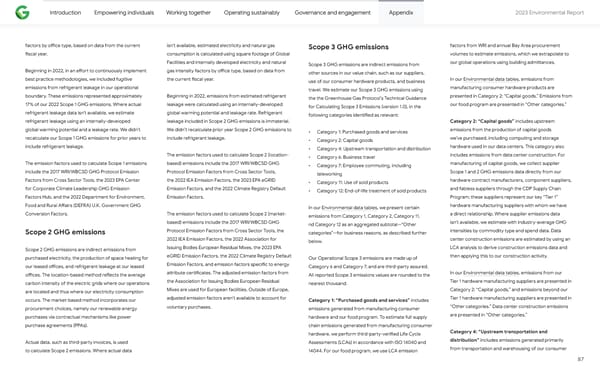Introduction Empowering individuals Working together Operating sustainably Governance and engagement Appendix 2023 Environmental Repo爀琀 factors by o昀케ce type, based on data from the current isn’t available, estimated electricity and natural gas Scope 3 GHG emissions factors from WRI and annual Bay Area procurement 昀椀scal year. consumption is calculated using square footage of Global volumes to estimate emissions, which we extrapolate to Facilities and internally developed electricity and natural our global operations using building admi琀琀ances. Scope 3 GHG emissions are indirect emissions from Beginning in 2022, in an e昀昀o爀琀 to continuously implement gas intensity factors by o昀케ce type, based on data from other sources in our value chain, such as our suppliers, best practice methodologies, we included fugitive the current 昀椀scal year. In our Environmental data tables, emissions from use of our consumer hardware products, and business emissions from refrigerant leakage in our operational manufacturing consumer hardware products are travel. We estimate our Scope 3 GHG emissions using boundary. These emissions represented approximately Beginning in 2022, emissions from estimated refrigerant presented in Category 2: “Capital goods.” Emissions from the the Greenhouse Gas Protocol’s Technical Guidance 17% of our 2022 Scope 1 GHG emissions. Where actual leakage were calculated using an internally-developed our food program are presented in “Other categories.” for Calculating Scope 3 Emissions (version 1.0), in the refrigerant leakage data isn’t available, we estimate global warming potential and leakage rate. Refrigerant following categories identi昀椀ed as relevant: refrigerant leakage using an internally-developed leakage included in Scope 2 GHG emissions is immaterial. Category 2: “Capital goods” includes upstream global warming potential and a leakage rate. We didn’t We didn’t recalculate prior year Scope 2 GHG emissions to • Category 1: Purchased goods and services emissions from the production of capital goods recalculate our Scope 1 GHG emissions for prior years to include refrigerant leakage. • Category 2: Capital goods we’ve purchased, including computing and storage include refrigerant leakage. • Category 4: Upstream transpo爀琀ation and distribution hardware used in our data centers. This category also The emission factors used to calculate Scope 2 (location- • Category 6: Business travel includes emissions from data center construction. For The emission factors used to calculate Scope 1 emissions based) emissions include the 2017 WRI/WBCSD GHG • Category 7: Employee commuting, including manufacturing of capital goods, we collect supplier include the 2017 WRI/WBCSD GHG Protocol Emission Protocol Emission Factors from Cross Sector Tools, Scope 1 and 2 GHG emissions data directly from our teleworking Factors from Cross Sector Tools, the 2023 EPA Center the 2022 IEA Emission Factors, the 2023 EPA eGRID • Category 11: Use of sold products hardware contract manufacturers, component suppliers, for Corporate Climate Leadership GHG Emission Emission Factors, and the 2022 Climate Registry Default • Category 12: End-of-life treatment of sold products and fabless suppliers through the CDP Supply Chain Factors Hub, and the 2022 Depa爀琀ment for Environment, Emission Factors. Program; these suppliers represent our key “Tier 1” Food and Rural A昀昀airs (DEFRA) U.K. Government GHG hardware manufacturing suppliers with whom we have In our Environmental data tables, we present ce爀琀ain Conversion Factors. The emission factors used to calculate Scope 2 (market- a direct relationship. Where supplier emissions data emissions from Category 1, Category 2, Category 11, based) emissions include the 2017 WRI/WBCSD GHG isn’t available, we estimate with industry-average GHG nd Category 12 as an aggregated subtotal—“Other Scope 2 GHG emissions Protocol Emission Factors from Cross Sector Tools, the intensities by commodity type and spend data. Data categories”—for business reasons, as described fu爀琀her 2022 IEA Emission Factors, the 2022 Association for center construction emissions are estimated by using an below. Issuing Bodies European Residual Mixes, the 2023 EPA LCA analysis to derive construction emissions data and Scope 2 GHG emissions are indirect emissions from eGRID Emission Factors, the 2022 Climate Registry Default then applying this to our construction activity. purchased electricity, the production of space heating for Our Operational Scope 3 emissions are made up of Emission Factors, and emission factors speci昀椀c to energy our leased o昀케ces, and refrigerant leakage at our leased Category 6 and Category 7, and are third-pa爀琀y assured. a琀琀ribute ce爀琀i昀椀cates. The adjusted emission factors from In our Environmental data tables, emissions from our o昀케ces. The location-based method re昀氀ects the average All repo爀琀ed Scope 3 emissions values are rounded to the the Association for Issuing Bodies European Residual Tier 1 hardware manufacturing suppliers are presented in carbon intensity of the electric grids where our operations nearest thousand. Mixes are used for European facilities. Outside of Europe, Category 2: “Capital goods,” and emissions beyond our are located and thus where our electricity consumption adjusted emission factors aren’t available to account for Tier 1 hardware manufacturing suppliers are presented in occurs. The market-based method incorporates our Category 1: “Purchased goods and services” includes “Other categories.” Data center construction emissions voluntary purchases. procurement choices, namely our renewable energy emissions generated from manufacturing consumer are presented in “Other categories.” purchases via contractual mechanisms like power hardware and our food program. To estimate full supply purchase agreements (PPAs). chain emissions generated from manufacturing consumer Category 4: “Upstream transpo爀琀ation and hardware, we pe爀昀orm third-pa爀琀y-veri昀椀ed Life Cycle distribution” includes emissions generated primarily Actual data, such as third-pa爀琀y invoices, is used Assessments (LCAs) in accordance with ISO 14040 and from transpo爀琀ation and warehousing of our consumer to calculate Scope 2 emissions. Where actual data 14044. For our food program, we use LCA emission 87
 2023 Environmental Report Page 86 Page 88
2023 Environmental Report Page 86 Page 88